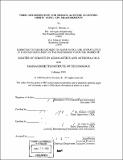| dc.contributor.advisor | Ronald J. Proulx and Paul J. Cefola. | en_US |
| dc.contributor.author | Neelon, Joseph G. (Joseph Gordon), 1968- | en_US |
| dc.contributor.other | Massachusetts Institute of Technology. Dept. of Aeronautics and Astronautics. | en_US |
| dc.date.accessioned | 2008-11-07T20:17:34Z | |
| dc.date.available | 2008-11-07T20:17:34Z | |
| dc.date.copyright | 1998 | en_US |
| dc.date.issued | 1999 | en_US |
| dc.identifier.uri | http://hdl.handle.net/1721.1/43609 | |
| dc.description | Thesis (S.M.)--Massachusetts Institute of Technology, Dept. of Aeronautics and Astronautics, February 1999. | en_US |
| dc.description | Includes bibliographical references (p. 231-236). | en_US |
| dc.description.abstract | Recent satellite constellation developers have increasingly considered non-traditional medium altitude circular and elliptical orbits. These projects will track their satellites using the GPS system, which has been used on LEO satellites for several years. But can GPS be used as the sole input for the orbit determination of satellites in these medium altitude eccentric orbits? To determine the feasibility of such a process, a program was constructed to produce simulated GPS navigation solutions. These simulated navigation solution were used in place of actual solutions that do not exist. The simulation included realistic error models for the GPS satellite clocks and for ionospheric delays, and it evaluated the visibility between the GPS satellites and their target. The navigation solutions were computed using all GPS signals received by the target satellite. To increase the speed of calculation, the simulation used a modified version of the self-scheduling architecture for parallel processing and implemented it using the MPI Standard. The orbits used in this simulation were the Ellipso Borealis, Ellipso Concordia, and Molniya orbits. The navigation solutions produced from these orbits were used as the input to an orbit determination process that employed the Goddard Trajectory Determination System (GTDS) program. This orbit determination process was performed using the differential corrections function of GTDS. The determined orbit was compared to the orbits used in the production of the simulated navigation solutions. The results of this comparison implied that the orbits could be reproduced from GPS navigation solutions if the precise force models were used in the determination process. Testing was conducted to examine the effects of force mismodeling on the orbit determination process. | en_US |
| dc.description.statementofresponsibility | by Joseph G. Neelon, Jr. | en_US |
| dc.format.extent | 236 p. | en_US |
| dc.language.iso | eng | en_US |
| dc.publisher | Massachusetts Institute of Technology | en_US |
| dc.rights | M.I.T. theses are protected by
copyright. They may be viewed from this source for any purpose, but
reproduction or distribution in any format is prohibited without written
permission. See provided URL for inquiries about permission. | en_US |
| dc.rights.uri | http://dspace.mit.edu/handle/1721.1/7582 | en_US |
| dc.subject | Aeronautics and Astronautics. | en_US |
| dc.title | Orbit determination for medium altitude eccentric orbits using GPS measurements | en_US |
| dc.title.alternative | Orbit determination for medium altitude eccentric orbits using Global Positioning System measurements | en_US |
| dc.type | Thesis | en_US |
| dc.description.degree | S.M. | en_US |
| dc.contributor.department | Massachusetts Institute of Technology. Department of Aeronautics and Astronautics | |
| dc.identifier.oclc | 48193475 | en_US |
